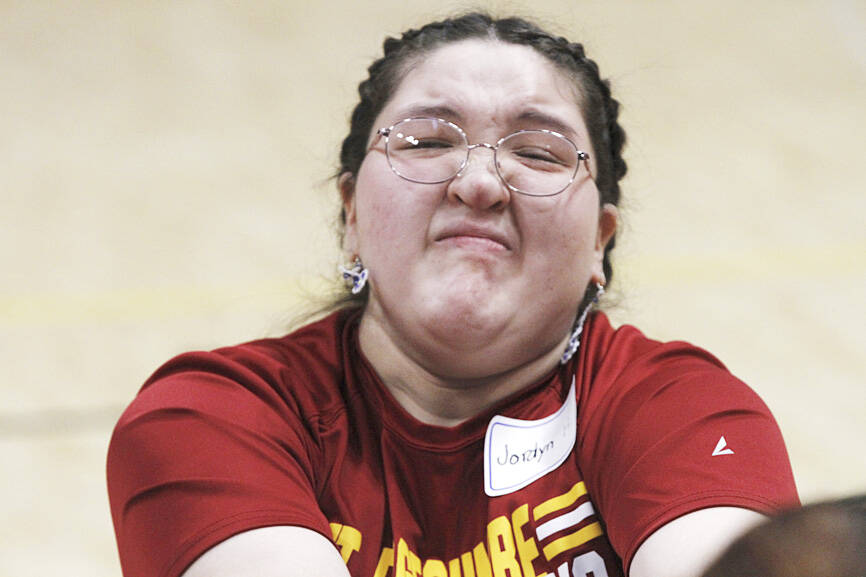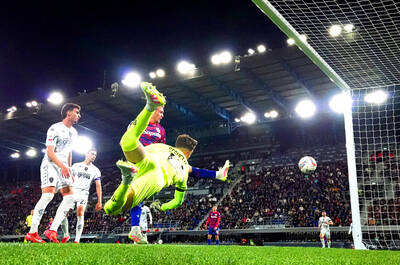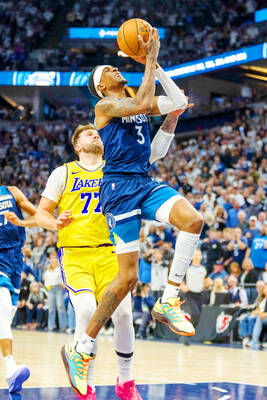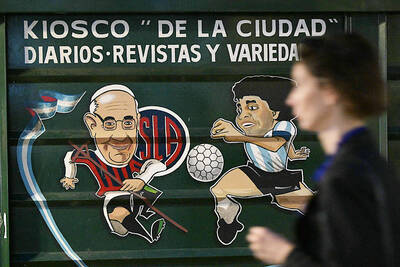The athletes filling a huge gym in Anchorage were ready to compete, cheering, stomping and high-fiving each other as they lined up for the chance to claim the state’s top prize in their events.
The teenagers were at the Native Youth Olympics, a statewide competition that attracts hundreds of Alaska Native athletes each year and pays tribute to the skills and techniques used by their ancestors to survive in the harsh polar climate.
Events at the competition that wrapped up on Saturday included a stick pull, meant to mimic holding onto a slippery seal as it fights to return to the water, and a modified, four-step broad jump that approximates leaping across ice floes on the frozen ocean.

Photo: AP
For generations, Alaska Natives played these games to develop the skills they needed to become successful hunters — and survive — in an unforgiving climate.
Now, today’s youth play “to help preserve our culture, our heritage and to teach our youth how difficult life used to be and to share our culture with everyone around us who wants to know more about our people,” said Nicole Johnson, the head official for the event and one of Alaska’s most decorated Native athletes.
Johnson has won more than 100 medals at Native Olympic competitions and for 29 years held the world record in the two-foot (61cm) high kick, an event where athletes jump with both feet, kick a ball, while keeping both feet even, and land on both feet. Her record of 6 feet, 6 inches (1.98m) was broken in 2014.
For the “seal hop,” a popular event on Saturday, athletes get into a push-up or plank position and shuffle across the floor on their knuckles — the same stealthy crawl their ancestors used during a hunt to sneak up on unsuspecting seals napping on the ice.
“And when they got close enough to the seal, they would grab their harpoon and get the seal,” said Johnson, an Inupiaq originally from Nome.
Colton Paul had the crowd clapping and stomping their feet. Last year, he set a world record in the scissors broad jump with a mark of 38 feet, 7 inches when competing for Mount Edgecumbe High School, a boarding school in Sitka. The jump requires power and balance, and includes four specific stylized leaps that mimic hop-scotching across floating ice chunks to navigate a frozen river or ocean.
The Yupik athlete from the western Alaska village of Kipnuk can no longer compete because he has graduated, but he performed for the crowd on Friday, jumping 38 feet, 9 inches.
He said that Native Youth Olympics is the only sport for which he has had a passion.
“Doing the sports has really made me had a sense of ‘My ancestors did this,’ and I’m doing what they did for survival,” Paul, 19, said. “It’s just something fun to do.”
Awaluk Nichols has competed in Native Youth Olympics for most of her childhood. The events give her a chance to explore her Inupiaq heritage, something she feels is slowly fading away from Nome, a Bering Sea coastal community.
“It helps me a lot to just connect with my friends and my culture, and it just means a lot to me that we still have it,” said the high-school junior, who listed her best event as the one-foot high kick.
Some events are as much of a mental test as a physical one. In one competition called the “wrist carry,” two teammates hold a stick at each end, while a third person hangs from the dowel by their wrist, legs curled up like a sloth, as their teammates run around an oval track.
The goal is to see who can hang onto the stick the longest without falling or touching the ground. The event builds strength, endurance and teamwork, and emulates the traits people of the north needed when they lived a nomadic lifestyle and had to carry heavy loads, organizers said.
Nichols said her family and some others still participate in some Native traditions, like hunting and subsisting off the land like their ancestors, but competing in the youth games “makes you feel really connected with them.”
“Just knowing that I’m part of what used to be — it makes me happy,” she said.

Bologna on Thursday advanced past Empoli to reach their first Coppa Italia final in more than half a century. Thijs Dallinga’s 87th-minute header earned Bologna a 2-1 win and his side advanced 5-1 on aggregate. Giovanni Fabbian opened the scoring for Bologna with a header seven minutes in. Then Viktor Kovalenko equalized for Empoli in the 30th minute by turning in a rebound to finish off a counterattack. Bologna won the first leg 3-0. In the May 14 final in Rome, Bologna are to face AC Milan, who eliminated city rivals Inter 4-1 on aggregate following a 3-0 win on Wednesday. Bologna last reached the

If the Wild finally break through and win their first playoff series in a decade, Minnesota’s top line likely will be the reason. They were all over the Golden Knights through the first two games of their NHL Western Conference quarter-finals series, which was 1-1 going back to Minnesota for Game 3 today. The Wild tied the series with a 5-2 win on Tuesday. Matt Boldy had three goals and an assist in the first two games, while Kirill Kaprizov produced two goals and three assists. Joel Eriksson Ek, who centers the line, has yet to get on the scoresheet. “I think the biggest

The Minnesota Timberwolves, with so many promising performances spoiled by late mistakes fresh in their memory bank, sure timed this strong finish well. Jaden McDaniels scored a career playoff-high 30 points and spearheaded Minnesota’s stifling defense on an ailing Luka Doncic, and the Timberwolves beat the Los Angeles Lakers 116-104 to take a 2-1 lead in the best-of-seven Western Conference first-round series in Minneapolis, Minnesota, on Friday night. “Jaden never looks tired. He looks like he could play 48 minutes,” said teammate Anthony Edwards, who had 29 points, eight rebounds and eight assists. Julius Randle added 22 points for the Wolves, who outscored

From a commemorative jersey to a stadium in his name, Argentine soccer organizers are planning a slew of tributes to their late “Captain” Pope Francis, eulogized as the ultimate team player. Tributes to the Argentine pontiff, a lifelong lover of the game, who died on Monday at the age of 88, have been peppered with soccer metaphors in his homeland. “Francisco. What a player,” the Argentine Football Federation (AFA) said, describing the first pope from Latin America and the southern hemisphere as a generational talent who “never hogged the ball” and who showed the world “the importance of having an Argentine captain,